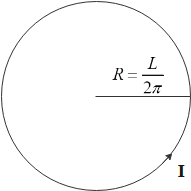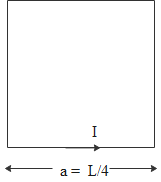Question
Question: Two identical wires A and B, each of length L, carry the same current I. Wire A is bent into a circl...
Two identical wires A and B, each of length L, carry the same current I. Wire A is bent into a circle of radius R and wire B is bent to form a square of side ‘a’. If BA and BB are the values of magnetic field at the centre of the circle and square respectively, then what is the value of the ratio BBBA?
A. 82π2
B. 8π2
C. 162π2
D. 16π2
Solution
Use expressions of magnetic field at the centre of the circular loop and magnetic field at the centre of the square to obtain BA and BB. Then take their ratio to obtain the result. Alternatively, We can also use Biot-Savart Law to find magnetic fields at centres of the circle and square. Biot-Savart law describes the magnetic field at a point due to a small current carrying segment. This segment is considered as vector quantity and its direction is along the direction of current.
Formula used:
Magnetic field in case of circle of radius R, B=2Rμ0I; Magnetic field in case of square of side a, B=πa24μ0I
Complete answer:
Both wires carry current I and are of length L.
Magnetic field for a circle of radius R is given by
B=2Rμ0I
Length of wire A is L and when the wire is bent into a circular loop its perimeter is equal to length of wire.
2πR=L⇒R=2πL

Therefore, magnetic field due to a circle formed by wire A
BA=2Rμ0I=22πLμ0I=Lπμ0I
Length of wire B is L and when the wire is bent into a square loop its perimeter is equal to length of wire.
4a=L⇒a=4L

Therefore, magnetic field due to a square formed by wire B
BB=πa24μ0I=π4L24μ0I=πL216μ0I
Taking ratios of BA and BB, we get
BBBA=πL216μ0ILπμ0I=Lπμ0I×16μ0IπL2
On simplifying
BBBA=82π2
So, the correct answer is “Option A”.
Note:
When two identical wires with same current flowing through them are bent to form square loop and circular loop respectively. The magnetic field due to the circular loop is approximately 0.87 times the magnitude of the magnetic field at the centre of the square.
